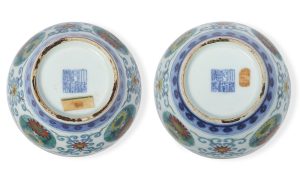Pratiksha Shome
At London’s Roseberys auction house, a pair of Qing dynasty jars sold for $74,318, more than their $63,000 estimate and about 3,000 times the $25 the seller spent for them at a charity store. Before the auction, Bill Forrest of the auction house told Artnet News that “these jars are extremely well-potted and painted with great skill and finesse.” Of course, considering the amount and diversity of gifts they get, charity shops can be excused for missing such specialised items as these. The seller has promised to provide a portion of the sale’s revenues to the store where the products were purchased.
The 4.5-inch-high jars were fired at Jingdezhen’s imperial kilns and embellished with lotus flower tendrils and flowering red and yellow chrysanthemum heads. For millennia, chrysanthemums have been a common motif in Chinese art, representing wealth and longevity. Major porcelain exhibitions in China and Japan have featured vessels with the same pattern.
The signature of the Qianlong Emperor, the fifth ruler of the Qing dynasty, who ruled from 1735 to 1796 before abdicating so as not to govern longer than his grandfather, may be seen on the pieces’ bases in underglaze blue.

Courtesy: Artnet news
The vases were made using the doucai technique, in which some of the design is painted in underglaze blue before firing; the remainder is added in different coloured overglaze enamels, and the jars are then fired at a lower temperature to establish the entire pattern. The terms “contrasted colours” and “dove-tailed colours” are a few options for translation. These works were produced in the Jingdezhen imperial factory, where the fashion was born. Other objects at the May 16 auction, which featured Southeast Asian, Chinese, and Japanese art, far exceeded their predictions in price. Among them were two Chinese zitan lantern stands that brought in about $89,000 despite having a high estimate of only $6,000 and a Qing dynasty dish that brought in more than $121,000 despite having the same high estimate.
Source: Artnet news






